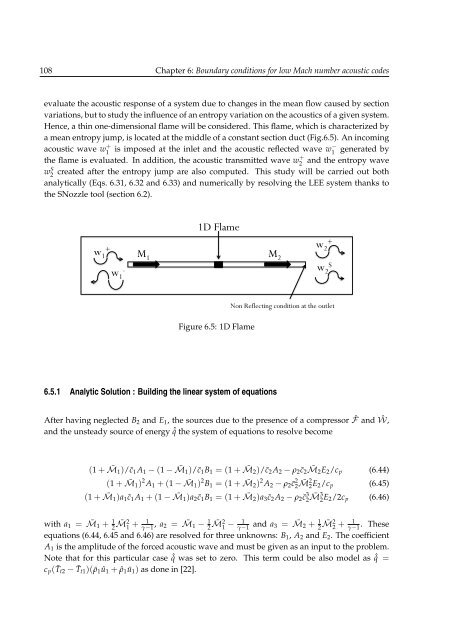THESE de DOCTORAT - cerfacs
THESE de DOCTORAT - cerfacs
THESE de DOCTORAT - cerfacs
Create successful ePaper yourself
Turn your PDF publications into a flip-book with our unique Google optimized e-Paper software.
108 Chapter 6: Boundary conditions for low Mach number acoustic co<strong>de</strong>s<br />
evaluate the acoustic response of a system due to changes in the mean flow caused by section<br />
variations, but to study the influence of an entropy variation on the acoustics of a given system.<br />
Hence, a thin one-dimensional flame will be consi<strong>de</strong>red. This flame, which is characterized by<br />
a mean entropy jump, is located at the middle of a constant section duct (Fig.6.5). An incoming<br />
acoustic wave w + 1 is imposed at the inlet and the acoustic reflected wave w− 1<br />
generated by<br />
the flame is evaluated. In addition, the acoustic transmitted wave w + 2<br />
and the entropy wave<br />
w2 S created after the entropy jump are also computed. This study will be carried out both<br />
analytically (Eqs. 6.31, 6.32 and 6.33) and numerically by resolving the LEE system thanks to<br />
the SNozzle tool (section 6.2).<br />
1D Flame<br />
w 1<br />
+<br />
w 1<br />
-<br />
M 1<br />
M 2<br />
w 2<br />
+<br />
w 2<br />
S<br />
Figure 6.5: 1D Flame<br />
Non Reflecting condition at the outlet<br />
6.5.1 Analytic Solution : Building the linear system of equations<br />
After having neglected B 2 and E 1 , the sources due to the presence of a compressor ˆ F and Ŵ,<br />
and the unsteady source of energy ˆ˙q the system of equations to resolve become<br />
(1 + ¯M 1 )/ ¯c 1 A 1 − (1 − ¯M 1 )/ ¯c 1 B 1 = (1 + ¯M 2 )/ ¯c 2 A 2 − ρ 2 ¯c 2 ¯M 2 E 2 /c p (6.44)<br />
(1 + ¯M 1 ) 2 A 1 + (1 − ¯M 1 ) 2 B 1 = (1 + ¯M 2 ) 2 A 2 − ρ 2 ¯c 2 2 ¯M 2 2 E 2/c p (6.45)<br />
(1 + ¯M 1 )a 1 ¯c 1 A 1 + (1 − ¯M 1 )a 2 ¯c 1 B 1 = (1 + ¯M 2 )a 3 ¯c 2 A 2 − ρ 2 ¯c 3 2 ¯M 3 2 E 2/2c p (6.46)<br />
with a 1 = ¯M 1 + 1 2 ¯M 2 1 + 1<br />
γ−1 , a 2 = ¯M 1 − 1 2 ¯M 2 1 − 1<br />
γ−1 and a 3 = ¯M 2 + 1 2 ¯M 2 2 + 1<br />
γ−1 . These<br />
equations (6.44, 6.45 and 6.46) are resolved for three unknowns: B 1 , A 2 and E 2 . The coefficient<br />
A 1 is the amplitu<strong>de</strong> of the forced acoustic wave and must be given as an input to the problem.<br />
Note that for this particular case ˆ˙q was set to zero. This term could be also mo<strong>de</strong>l as ˆ˙q =<br />
c p ( ¯T t2 − ¯T t1 )( ¯ρ 1 û 1 + ˆρ 1 ū 1 ) as done in [22].
















